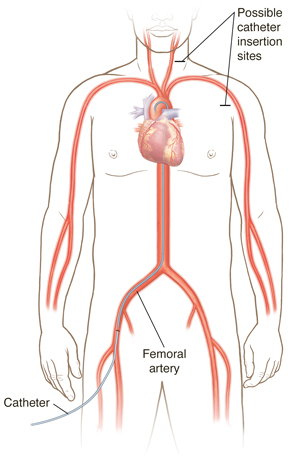Understanding Transcatheter Aortic Valve Replacement (TAVR)
Transcatheter aortic valve replacement (TAVR) is a procedure to replace a diseased aortic valve with a new tissue or biologic valve. The old heart valve is not removed but works like an anchor for the new heart valve. This procedure is done through small incisions using a long thin tube (catheter), X-rays, and ultrasound. Transcatheter aortic valve replacement is also known as transcatheter aortic valve implantation (TAVI).
The aortic valve directs blood flow from the heart (left ventricle) into the aorta (large blood vessel) and carries blood to the rest of the body. In some people, the valve becomes scarred and stiff and has trouble opening. This is a condition called aortic stenosis. The heart then has to work harder to push blood through the narrowed heart valve to the rest of the body. Over time, the extra work can cause the heart muscle to weaken. This may lead to symptoms, such as tiredness, shortness of breath, chest pain, and fainting. It can lead to heart failure.
In TAVR, the catheter is usually placed in the femoral artery in your groin. Sometimes, the catheter is placed through the axillary artery near your armpit or the carotid artery in your neck. Occasionally, the catheter is placed through a small incision in your chest underneath the collarbone or an incision between the ribs. The doctor uses the catheter to bring the new valve to your heart. The new valve is made of cow or pig heart tissue and is mounted on a metal frame. The new valve helps improve blood flow from the heart to the rest of the body.

Reasons for TAVR
TAVR may be a option for some people instead of surgical aortic valve replacement (SAVR). This will be based on age, surgical risks, how severe your aortic stenosis is, other medical factors, and other cardiac issues. Your healthcare team will determine if TAVR is an option for you.
Risks and possible complications
TAVR is very effective in most people. However, all medical procedures carry some risks and possible complications. Some common risks of TAVR include:
-
Bleeding or the need for a blood transfusion
-
Anemia (not enough red blood cells in the blood)
-
Blood clots
-
Infection
-
Collection of fluid around your heart (pericardial effusion)
-
Confusion or memory problems
-
Damage to the heart
-
Damage to your blood vessels
-
Failure of the new valve
-
Heart attack
-
Heart rhythm problems that may need a pacemaker
-
Kidney damage or failure
-
Lung puncture
-
Stroke
-
Risks of anesthesia (including death)
-
Rarely, the new heart valve can move out of position after it has been implanted
-
Leaking of blood in or around the new heart valve
You may have other risks, depending on your medical condition. Be sure to talk with your healthcare provider if you have any concerns before the procedure.
Life after a heart valve replacement
-
A new heart valve can help ease symptoms you may have had. These include pain or pressure in your chest, shortness of breath, and tiredness.
-
After the surgery, you will need to take aspirin or other blood-thinning medicine every day. You will likely also need to take an antiplatelet medicine for a certain period of time. These medicines help prevent blood clots in your new valve.
-
You will need to take antibiotics before you have dental work and certain other medical procedures, as prescribed by your healthcare provider. This is to help prevent bacteria from harming your new heart valve.
-
Your healthcare provider may tell you to make some lifestyle changes to protect your heart and make it stronger. These include exercise, quitting smoking, and keeping a healthy weight.
-
After your recovery from TAVR, you may be able to return to regular activities. You should notice improvement in the symptoms from your heart valve disease. Be sure to talk to your healthcare provider before starting any exercise program.